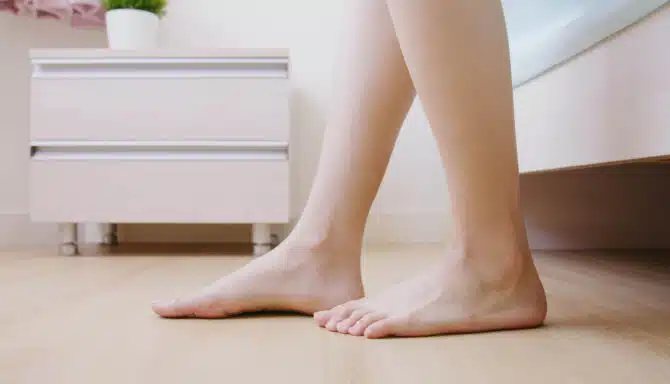Compression stockings are very popular among people with varicose veins. As the veins become painful and your legs feel heavy and tired, wearing them every day is often one of the only ways people feel comfort and relief (don’t worry, most types are stylish and/or discrete). Finding the best compression stockings for varicose veins involves visiting a doctor (to assess whether you can use compression stockings) and then attending a fitting at a foot clinic where you will discover:
- The type of compression stocking you need
- The right level of compression
- Your size
According to the National Library of Medicine, doctors and chiropodists recommend compression stockings not only because they help patients manage pain, but they’re also easier to use than bandages and pneumatic devices.
Here is an example of someone using compression stockings for a long plane ride. They also use the compression stockings if they are going on long car trips.
Let’s discuss everything you need to know about varicose veins and compression stockings.
Types of Compression Stockings for Varicose Veins
Varicose veins often develop in the calf area towards the back and the side of the lower leg. This is the main area where the large veins that take blood back to your heart travel. The valves within the veins that allow blood to go up the leg against gravity become weak and with constant walking or standing/ sitting still over time, those valves can weaken quicker. The valves become less efficient, you have a little back flow of blood causing the varicose veins.
As a result, knee-high compression socks are often the best type of compression stockings to invest in for varicose vein treatment. However, any vein in the leg can become varicose, so you may need thigh-high or pantyhose compression hosiery.

Compression Levels for Varicose Veins
Compression stockings have different compression levels, and stockings with more compression are tighter. You can often buy stockings in the 8-15 or 15-20 mmHg range at drug stores, but someone with varicose veins will need more compression from medical-grade stockings.
To adequately support blood flow and circulation and provide comfort and support, Sigvaris recommends a compression level of 20-30 mmHg for varicose vein treatment. Sigvaris was one of the first companies to discover how compression stockings can help with reducing leg swelling from odema.
However, if your varicose veins are severe, you should look into graduated compression in the 30-40 mmHg range. Lastly, compression levels should always be the highest in the area with the varicose veins.
While this should give you a general idea, your family doctor will know the right level of compression you need. Once you’ve gone to your family doctor and received your compression stockings prescription, you can then bring the prescription to your local foot clinic to get measured and fitted. Note: only a medical doctor can issue a prescription for compression stockings with the appropriate level of compression.
If the compression level is too high then it can actually reduce blood flow and your legs can become sore.

Compression Stocking Sizes
During your compression stocking fitting, a certified fitter at your foot clinic will determine what size you need and order the stockings after selecting from a size chart. Sizes for medical grade compression stockings (20-30 mmHg and above) are quite specific and require measuring; compression stockings will not work if they don’t fit well.
To ensure they order the right size and therefore the right compression stocking for you, your fitter will measure the following:
- Calf circumference
- Calf length
- Ankle circumference
- Hip circumference (for pantyhose)
- Leg length (for thigh-high and pantyhose compression stockings)
- Thigh circumference (for thigh-high and pantyhose compression stockings)
Your fitter will also go over the various style and material options and help you select the option that works best for your activities. Some activities and jobs can especially benefit from compression stockings – like flight attendants! Check out the video below to see how compression stockings can help flight attendants and people whose jobs require them to be on their feet all day:
How do you put on compression stockings?
Compression stockings are tighter than regular socks due to their compression, which can make them feel “tight”. This compression is needed to stimulate blood flow. However, it can also make compression stockings notoriously difficult to put on if you’re not using the correct technique. Fortunately, there are tricks to make it easier to put on your compression stockings. Here are some techniques and tips on how to put on compression socks:
If you need your legs to be professionally measured, given advice on compression stocking use and maintenance then speak to our knowledgeable staff and certified compression fitters. They would be happy to help you with any compression stocking help and question.











